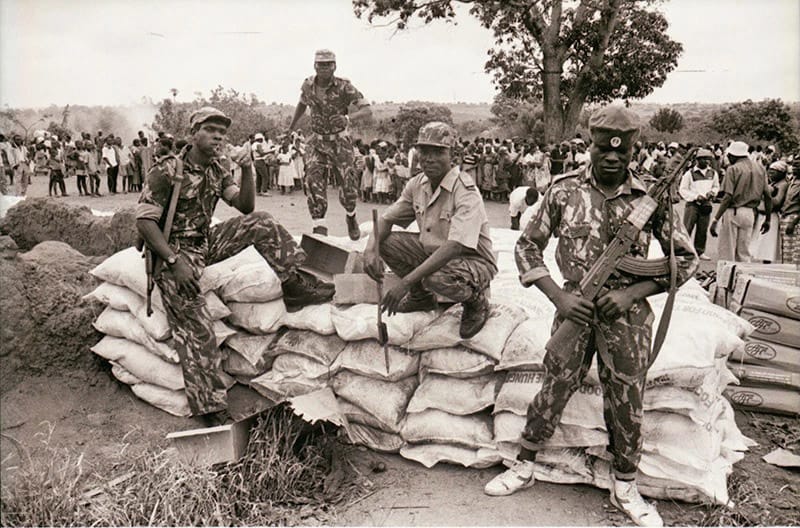Mozambique, a scenic country in Southeast Africa, was one of the last African countries to gain independence from European colonial powers. For nearly 500 years, the Portuguese subjected the people of Mozambique to socio-economic exploitation and violent suppression. But the people took up arms and repeatedly fought back, first in scattered uprisings, then in fierce, calculated wars that finally saw them break free in June 1975.
In this article, we will dive into Mozambique's long and painful journey towards independence from Portugal.
The Portuguese Arrival
In 1497, Portuguese explorer Vasco da Gama set sail on a historic voyage that, by 1498, had taken him around the Cape of Good Hope in modern-day South Africa and into the Indian Ocean. This marked the first direct European maritime entry into the Indian Ocean, with stops along the Mozambican coast and East African cities such as Mombasa and Malindi. What began as a strategic effort to establish a presence on the Indian trade route soon evolved into a broader campaign for influence and control by the Portuguese.
By the early 16th century, Portugal had gained control of the Island of Mozambique and the port city of Sofala—now Nova Sofala. Initially, the Portuguese were less interested in colonisation and more focused on gold trade. They set up garrisons and trading posts at Sena and Tete, strategically situated along the Zambezi River to tap into the gold trade. By the 1560s, the Portuguese had finally secured direct relations with the Mwenemutapa, the ruler of the Mutapa Empire in modern-day Zimbabwe and part of Mozambique.
To consolidate their trade and assert greater control inland, the Portuguese established prazos—large land estates in the Zambezi Valley—granted to settlers, soldiers, and officials. Over time, many of these settlers intermarried with local African communities, and the prazos evolved into Afro-Portuguese centers of power, blending European and African cultural elements. These estates became semi-autonomous, often passed down through local matrilineal lines, and played a key role in regional trade and governance.
Most prazos had declined by the mid-19th century, but some surviving estates continued to resist direct Portuguese authority well into the final decades of the century. Meanwhile, Portuguese influence along the northern Swahili coast had long since waned, with Omani Arabs dominating key trade hubs like Mombasa from the 18th century onward. Moreover, by the late 19th century, Britain and France had significantly intensified their imperial ambitions in Africa, accelerating the colonial scramble for territory.
Portuguese East Africa
By the late 19th century, Mozambique had formally become ‘Portuguese East Africa’. This was following the Berlin Conference (1884-85), which divided Africa between European powers. Compared to the British and French, the Portuguese had a smaller territorial claim concentrated in East and West Africa. Thus, Portugal felt pressured to assert tighter control over its claimed territories.
Control was often subcontracted to private chartered companies such as the Mozambique Company, the Niassa Company, and the Zambezia Company. These companies enjoyed near-total authority over governance, including taxation and labour recruitment.
This changed in 1926, when Lisbon (the Portuguese Capital) assumed direct control over Mozambique, following a coup that established the Portuguese Second Republic. A governor-general based in Lourenço Marques (now Maputo) presided over a small European bureaucracy. Africans were treated as subjects rather than citizens and were forced into a discriminatory system that classified them as ‘indigenous’ unless they achieved ‘assimilado’ status—a coveted and rarely awarded designation.
Weakened by internal political strife and economic crises in Portugal, the colonial administration increasingly relied on Mozambique as a key source of revenue. To extract this wealth, they imposed a harsh system of forced labor known as chibalo, which compelled indigenous Mozambicans to work on plantations, in mines, and on infrastructure projects for little or no pay. Additionally, colonial tax policies required payments in cash, pushing many into the exploitative labor market simply to meet their fiscal obligations.
Infrastructure, like ports and railways, was designed solely to serve colonial trade interests, while education and healthcare for indigenes remained virtually nonexistent. Moreso, European settlers seized the most fertile lands, while indigene farmers were either pushed onto marginal lands or coerced into producing cash crops for export. This all led to the creation of a society where stratification and racial discrimination were rife.
Early Resistance to Portuguese Rule
Resistance to Portuguese rule in Mozambique began almost from the beginning. In the 16th and 17th centuries, sporadic uprisings against the prazo feudal lords flared in the Zambezi Valley. For clarity, while the Afro-Portuguese prazo lords resisted direct Portuguese rule, they themselves exploited the indigenous population who soon started fighting back.
By the late 19th century, larger African polities began resisting Portuguese domination directly. One notable leader was Ngungunyane (also Gungunhana), the emperor of the short-lived Gaza Empire. Ngungunyane was the grandson of Soshangane, the founder and first monarch of the empire which covered all of present-day Mozambique at its peak.
Ngungunyane ascended the throne in 1885 and from then on fiercely opposed Portuguese expansion into southern Mozambique. His forces successfully held off Portuguese expeditions for years. But in 1895, using trickery and superior weaponry, the Portuguese defeated Ngungunyane at the Battle of Coolela. He was then captured and exiled to the Azores where he died. Still, his defiance became a source of motivation for later generations.
Throughout the colonial period, many smaller Mozambican communities maintained covert forms of resistance. They retained their indigenous governance structures, sabotaged colonial enterprises and sometimes fled into neighbouring territories.
The Rise of Organised Nationalism
By the mid-20th century, the winds of decolonisation sweeping across Africa began to reach Mozambique. Across the continent, European empires were crumbling under the weight of organised nationalist movements. The independence of Ghana (1957), and the African nations that followed suit, galvanised a new generation of Mozambican leaders.
In 1962, the Front for the Liberation of Mozambique (FRELIMO) was formed from three major nationalist groups: the Mozambican African National Union (MANU), the National African Union of Independent Mozambique (UNAMI), and the Mozambique African National Union (UNAMI).
Led by US-educated anthropologist Eduardo Mondlane, FRELIMO set its sights firmly on independence. Unlike earlier uprisings, FRELIMO was organised, ideologically driven, and connected to a broader Pan-African and global anti-colonial movement. They set up their headquarters in Dar es Salaam Tanzania, allowing for combat training and proper coordination.
The War of Liberation
In September 1964, FRELIMO launched a guerilla campaign against Portuguese colonial forces in Cabo Delgado province. This campaign was the last branch of the 13-year Portuguese Colonial War that had started in Angola (1961) and Guinea-Bissau (1963).
Employing classic guerrilla warfare tactics, FRELIMO focused on sabotage, ambushes and the establishment of ‘liberated zones’ where they built rudimentary governance structures, schools, and clinics. By 1966, a second front had been opened in Niassa Province, stretching Portuguese forces even thinner.
Despite Portugal's military superiority, the rugged terrain, FRELIMO’s popular support, and the growing international pressure made it a costly and unwinnable war for Lisbon. In retaliation, Portugal embarked on brutal counterinsurgency measures. Villages were burned. Civilians were massacred. But such strong persecution only deepened rural support for the rebels.
Tragically, in February 1969, Mondlane was assassinated by a parcel bomb believed to have been sent by Portuguese agents. While the enemy camp expected this to make FRELIMO fall apart, another leader called Samora Machel brilliantly rose up to the occasion. The rest of the world had grown hostile towards Portugal’s insistence on holding on to colonial power, and so Machel built on that. He forged stronger alliances with sympathetic countries like Tanzania, Algeria, and the Soviet Union, ensuring a steady flow of arms and support.
In 1970, Portugal launched Operation Gordian Knot, its largest and most expensive military offensive against FRELIMO. Though it achieved some disruption, it failed to crush the resistance, and by 1972, FRELIMO controlled large parts of northern Mozambique.
The Carnation Revolution and Mozambique's Independence
While FRELIMO’s struggle continued, events in Portugal dramatically shifted the playing field in Mozambique’s favour. On 25 April 1974, junior military officers in Lisbon overthrew the authoritarian Second Portuguese Republic in what became known as the Carnation Revolution. Worn out by endless colonial wars in Africa, the new Portuguese government opened the floor for independence negotiations.
Talks between FRELIMO and Portuguese authorities culminated in the Lusaka Accord of 7 September 1974. Formal independence was declared on 25 June 1975, with Samora Machel sworn in as the first president of the People's Republic of Mozambique.
The victory was monumental. Mozambique had become one of the few African nations to win independence through sustained armed struggle. Mozambique was the second of its peers to gain independence, following Guinea-Bissau’s in September 1974. Angola’s independence in November 1975 marked the end of the Portuguese Colonial War.
The Legacy of Resistance
Mozambique’s fight for freedom came at a staggering cost. Tens of thousands died, many more were displaced, and the economy took a huge blow. Yet out of that sacrifice was born a resilient sense of national identity, built not by colonial design but through collective struggle.
Post-independence, Mozambique faced new challenges, including a brutal civil war and economic hardship. But the memory of resistance—of refusing to bow to centuries of oppression—remains central to Mozambican pride.
Today, Mozambique’s fight for freedom stands as a testament to the courage of a people who refused to be conquered.

Oyindamola Depo Oyedokun
Oyindamola Depo Oyedokun is an avid reader and lover of knowledge, of most kinds. When she's not reading random stuff on the internet, you'll find her putting pen to paper, or finger to keyboard.
follow me :
Leave a Comment
Sign in or become a Africa Rebirth. Unearthing Africa’s Past. Empowering Its Future member to join the conversation.
Just enter your email below to get a log in link.


Related News
Congo’s Unfinished Revolution: Patrice Lumumba and the Struggle for Sovereignty
Jun 01, 2025
When Oil Was Worth More Than Lives: Britain’s Role in the Biafran War
May 31, 2025
The Influence of African Literature on World Literature
May 24, 2023